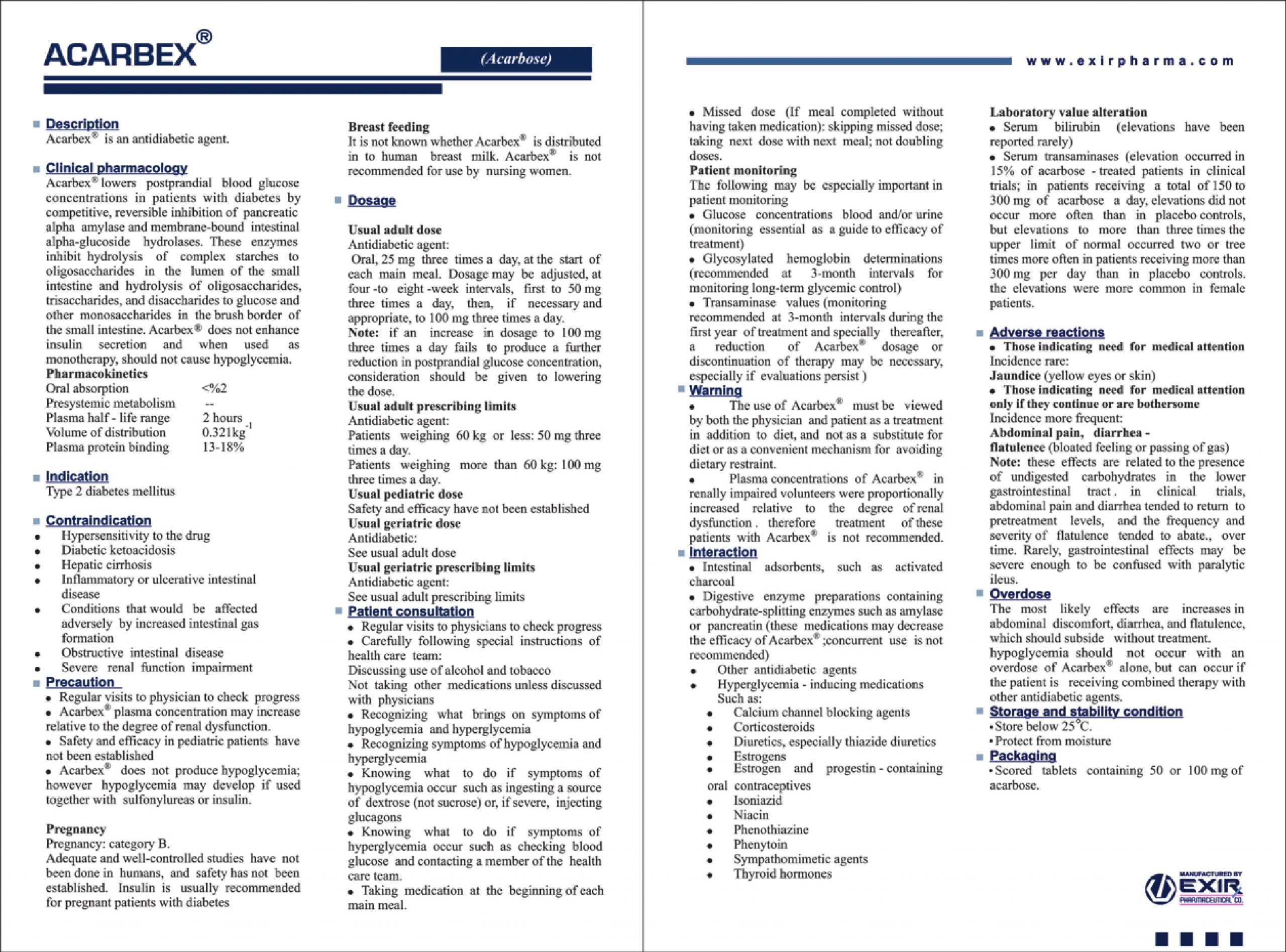ACARBEX 50 , 100
Scored tablet Acarbose 50 , 100 mg

| Generic Name of Product | Brand Name | Dosage Form | Strength | Pharmacologic Group | Therapeutic Group | Unit Per Pack |
| Acarbose | Acarbex® | Tablet | 50 , 100 mg | Antidiabetic agent, Alpha-glucosidase inhibitor | Antidiabetics | 30 |
Indications And Usage |
As an adjunct to diet and exercise to improve glycemic control in adults with type 2 diabetes mellitus. |
Administration |
Dosage must be individualized on the basis of both effectiveness and tolerance while not exceeding the maximum recommended dose of 100 mg t.i.d. Acarbose should be taken three times daily at the start (with the first bite) of each main meal. Acarbose should be started at a low dose, with gradual dose escalation as described below, both to reduce gastrointestinal side effects and to permit identification of the minimum dose required for adequate glycemic control of the patient. If the prescribed diet is not observed, the intestinal side effects may be intensified. If strongly distressing symptoms develop in spite of adherence to the diabetic diet prescribed, the doctor must be consulted and the dose temporarily or permanently reduced. Initial DosageThe recommended starting dosage of Acarbose is 25 mg given orally three times daily at the start (with the first bite) of each main meal. However, some patients may benefit from more gradual dose titration to minimize gastrointestinal side effects. This may be achieved by initiating treatment at 25 mg once per day and subsequently increasing the frequency of administration to achieve 25 mg t.i.d. Maintenance DosageOnce a 25 mg t.i.d. dosage regimen is reached, dosage of Acarbose should be adjusted at 4–8 week intervals based on one-hour postprandial glucose or glycosylated hemoglobin levels, and on tolerance. The dosage can be increased from 25 mg t.i.d. to 50 mg t.i.d. Some patients may benefit from further increasing the dosage to 100 mg t.i.d. The maintenance dose ranges from 50 mg t.i.d. to 100 mg t.i.d. However, since patients with low body weight may be at increased risk for elevated serum transaminases, only patients with body weight > 60 kg should be considered for dose titration above 50 mg t.i.d. If no further reduction in postprandial glucose or glycosylated hemoglobin levels is observed with titration to 100 mg t.i.d., consideration should be given to lowering the dose. Once an effective and tolerated dosage is established, it should be maintained. Maximum Dosage:The maximum recommended dose for patients ≤ 60 kg is 50 mg t.i.d. The maximum recommended dose for patients > 60 kg is 100 mg t.i.d.. |
Contraindications |
Acarbose is contraindicated in patients with known hypersensitivity to the drug. Acarbose is contraindicated in patients with diabetic ketoacidosis or cirrhosis. Acarbose is also contraindicated in patients with inflammatory bowel disease, colonic ulceration, and partial intestinal obstruction or in patients predisposed to intestinal obstruction. In addition, Acarbose is contraindicated in patients who have chronic intestinal diseases associated with marked disorders of digestion or absorption and in patients who have conditions that may deteriorate as a result of increased gas formation in the intestine. |
Precautions |
Macrovascular Outcomes, Elevated Serum Transaminase Levels, Loss of Control of Blood Glucose |
Adverse Reactions |
abdominal pain, diarrhea, and flatulence were 19%, 31%, and 74% |
Pregnancy and lactation |
Unknown |
Renal and liver Impairment |
Plasma concentrations of Acarbose in renally impaired volunteers were proportionally increased relative to the degree of renal dysfunction. Long-term clinical trials in diabetic patients with significant renal dysfunction (serum creatinine > 2.0 mg/dL) have not been conducted. Therefore, treatment of these patients with Acarbose is not recommended. |
Laboratory Tests |
Therapeutic response to Acarbose should be monitored by periodic blood glucose tests. Measurement of glycosylated hemoglobin levels is recommended for the monitoring of long-term glycemic control. PRECOSE, particularly at doses in excess of 50 mg t.i.d., may give rise to elevations of serum transaminases and, in rare instances, hyperbilirubinemia. It is recommended that serum transaminase levels be checked every 3 months during the first year of treatment with PRECOSE and periodically thereafter. If elevated transaminases are observed, a reduction in dosage or withdrawal of therapy may be indicated, particularly if the elevations persist. Monitoring glycemic control with 1,5-AG assay is not recommended as measurements of 1,5-AG are unreliable in assessing glycemic control in patients taking acarbose. Use alternative methods to monitor for glycemic control. |

